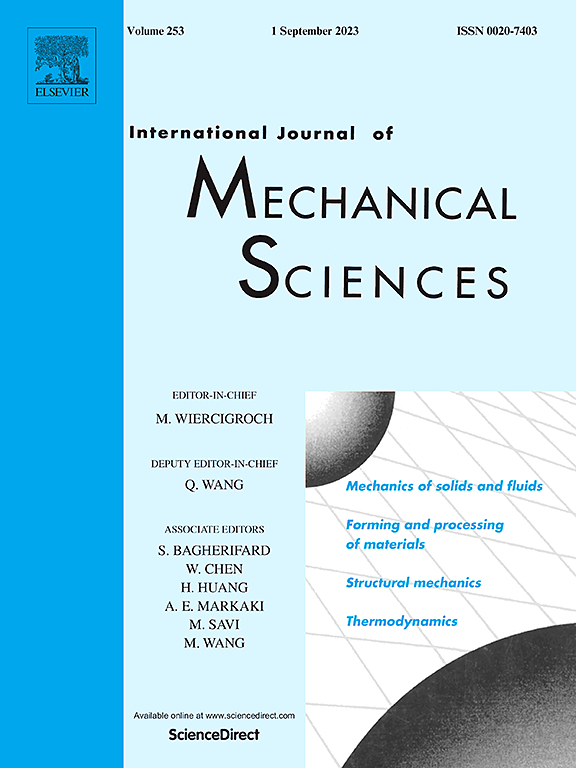An origami-inspired low-frequency isolator with one/two-stage quasi-zero stiffness characteristics
IF 7.1
1区 工程技术
Q1 ENGINEERING, MECHANICAL
International Journal of Mechanical Sciences
Pub Date : 2025-02-09
DOI:10.1016/j.ijmecsci.2025.110040
引用次数: 0
Abstract
As an emerging technology, Kresling origami exhibits rich nonlinear mechanical and kinematic properties. However, previous studies have tended to focus on one of these properties, and few have utilized its kinematic properties to design specifical mechanical properties. Inspired by the axis-rotation coupling property of Kresling origami, a novel composite anti-vibration structure (CAS) utilizing an improved cam-roller mechanism is proposed for flexible low-frequency vibration isolation. The mountain creases are simulated by rigid rods, while the valley creases are neglected to enhance the axis-rotation coupling effect as much as possible. Unlike conventional cam-roller mechanisms, the improved cam-roller mechanism overcomes the cam size limitation on working stroke and avoids friction damping of the sliding rods. By setting different cam profiles, one/two-stage quasi-zero stiffness (QZS) characteristics with wide QZS ranges can be achieved, thus enabling passive variable loading of CAS. Considering the nonlinear inertia induced by the rotating platform, the dynamic equations of CAS are established using Lagrange principle. And the Alternating frequency–time harmonic balance method is used to solve the equations, which avoids the fitting error caused by Taylor's formula. The effects of nonlinear inertia, equilibrium position, excitation amplitude, and damping on vibration isolation performance of the CAS are analyzed. It is found that changes in excitation amplitude and equilibrium position affect both nonlinear stiffness and inertia, thus affecting vibration isolation performance. Comparative discussions demonstrate CAS has wider QZS ranges and weaker stiffness nonlinearity than typical QZS isolators, X-shaped isolators, and linear isolators, which leads to superior low-frequency vibration isolation at large excitations. Both static and dynamic experiments verify the accuracy of the theoretical analysis, confirming wide QZS range and excellent low-frequency vibration isolation performance of CAS. This work presents a simple, feasible low-frequency vibration isolation scheme that may promote practical engineering applications of origami and cam-roller structures.

求助全文
约1分钟内获得全文
求助全文
来源期刊

International Journal of Mechanical Sciences
工程技术-工程:机械
CiteScore
12.80
自引率
17.80%
发文量
769
审稿时长
19 days
期刊介绍:
The International Journal of Mechanical Sciences (IJMS) serves as a global platform for the publication and dissemination of original research that contributes to a deeper scientific understanding of the fundamental disciplines within mechanical, civil, and material engineering.
The primary focus of IJMS is to showcase innovative and ground-breaking work that utilizes analytical and computational modeling techniques, such as Finite Element Method (FEM), Boundary Element Method (BEM), and mesh-free methods, among others. These modeling methods are applied to diverse fields including rigid-body mechanics (e.g., dynamics, vibration, stability), structural mechanics, metal forming, advanced materials (e.g., metals, composites, cellular, smart) behavior and applications, impact mechanics, strain localization, and other nonlinear effects (e.g., large deflections, plasticity, fracture).
Additionally, IJMS covers the realms of fluid mechanics (both external and internal flows), tribology, thermodynamics, and materials processing. These subjects collectively form the core of the journal's content.
In summary, IJMS provides a prestigious platform for researchers to present their original contributions, shedding light on analytical and computational modeling methods in various areas of mechanical engineering, as well as exploring the behavior and application of advanced materials, fluid mechanics, thermodynamics, and materials processing.
 求助内容:
求助内容: 应助结果提醒方式:
应助结果提醒方式:


